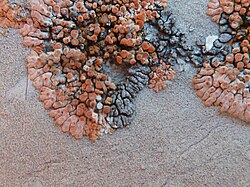Biology:Calogaya arnoldii
| Calogaya arnoldii | |
|---|---|

| |
| Calogaya arnoldii (orange thallus) parasitised by the lichenicolous fungus Verrucula arnoldaria (darkened parts) | |
| Scientific classification | |
| Domain: | Eukaryota |
| Kingdom: | Fungi |
| Division: | Ascomycota |
| Class: | Lecanoromycetes |
| Order: | Teloschistales |
| Family: | Teloschistaceae |
| Genus: | Calogaya |
| Species: | C. arnoldii
|
| Binomial name | |
| Calogaya arnoldii (Wedd.) Arup, Frödén & Søchting (2013)
| |
| Synonyms[1] | |
| |
Calogaya arnoldii is a species of saxicolous (rock-dwelling), crustose lichen that is common and widespread in Europe and Asia. It is in the family Teloschistaceae.[2] It was first formally described as a new species in 1876 by Hugh Algernon Weddell, as a species of Lecanora.[3] After being transferred to Caloplaca in 1915,[4] it was considered as a member of that genus for nearly a century. Molecular phylogenetic studies showed Caloplaca to be polyphyletic, and it was divided up into several smaller genera in 2013. Calogaya arnoldii was one of eight species transferred to the newly circumscribed Calogaya by Ulf Arup, Patrik Frödén, and Ulrik Søchting.[5] The lichen is part of a species complex with complicated taxonomy, and in which intermediate phenotypes are frequently observed, making it difficult to reliably distinguish them.[6] Calogaya saxicola is one such similar species, and it has often been confused with C, arnoldii in areas where they co-occur, as the differences between them are subtle.[7]
Verrucula arnoldaria is a lichenicolous lichen that parasitises Calogaya arnoldii.[8]
References
- ↑ "Synonymy. Current Name: Calogaya arnoldii (Wedd.) Arup, Frödén & Søchting, Nordic Jl Bot. 31(1): 38 (2013)". Species Fungorum. http://www.speciesfungorum.org/Names/SynSpecies.asp?RecordID=802314.
- ↑ "Calogaya arnoldii (Wedd.) Arup, Frödén & Søchting". Species 2000: Naturalis, Leiden, the Netherlands. https://www.catalogueoflife.org/data/taxon/68VGD.
- ↑ Weddell, H.A. (1876). "Notices monographique sur les Amphiloma de la flore Francaise" (in fr). Bulletin de la Société Botanique de France 23: 82–99.
- ↑ Ginzberger, A. (1915). "Beiträge zur Naturgeschichte der Scoglien und kleineren Inseln Süddalmatiens" (in de). Denkschriften der Akademie der Wissenschaften (Wien) Mathematisch-naturwissenschaftliche Klasse 92: 301–322 [319].
- ↑ Arup, Ulf; Søchting, Ulrik; Frödén, Patrik (2013). "A new taxonomy of the family Teloschistaceae". Nordic Journal of Botany 31 (1): 16–83. doi:10.1111/j.1756-1051.2013.00062.x.
- ↑ Jüriado, Inga; Marmor-Ohtla, Liis; Martin, Ljudmilla; Randlane, Tiina; Suija, Ave (2022). "Updates to the list of Estonian lichenized, lichenicolous and allied fungi". Folia Cryptogamica Estonica 59: 83–89. doi:10.12697/fce.2022.59.8132.
- ↑ Vondrák, Jan; Frolov, Ivan; Davydov, Evgeny A.; Urbanavichene, Irina; Chesnokov, Sergey; Zhdanov, Ilya; Muchnik, Evgenia; Konoreva, Ludmila et al. (2016). "The extensive geographical range of several species of Teloschistaceae: evidence from Russia". The Lichenologist 48 (3): 171–189. doi:10.1017/s0024282916000116.
- ↑ Diederich, Paul; Lawrey, James D.; Ertz, Damien (2018). "The 2018 classification and checklist of lichenicolous fungi, with 2000 non-lichenized, obligately lichenicolous taxa". The Bryologist 121 (3): 340–425 [366]. doi:10.1639/0007-2745-121.3.340. https://www.researchgate.net/publication/328374342.
Wikidata ☰ Q25412858 entry
 |

